Con esta copa de vino deseo un Feliz Año Nuevo para todos.
De inmediato comienzo mi publicación de hoy.
With this glass of wine I wish a Happy New Year to all.
I immediately begin my publication todayy.

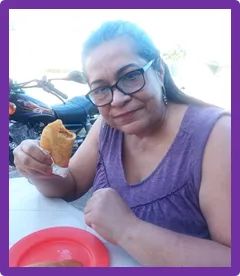

Les cuento que ayer muy temprano, me invitaron a comer empanadas, un plato muy popular acá en Venezuela elaborado generalmente con masa de harina de maíz, pero que también puede utilizarse harina de trigo.
Sus rellenos varían desde: queso blanco, carne molida o desmechada, chorizo, pescado y otros productos del mar, entre otros.
En esta oportunidad yo me comí tres: una de carne desmechada, una de pescado y una de chorizo.
Los cierto es, que estas empanadas me llevaron a tomar la decisión de cocinarle a mi familia, unas arepas con carne mechada.
En otra oportunidad les mostraré como preparar unas empanadas, pero hoy prepararé unas arepas.
Early yesterday morning, I was invited to eat empanadas, a very popular dish here in Venezuela, usually made with corn flour dough, but wheat flour can also be used.
Its fillings vary from: white cheese, ground or shredded meat, chorizo, fish and other seafood, among others.
This time I ate three of them: one with shredded meat, one with fish and one with chorizo.
The truth is that these empanadas made me decide to cook some arepas with shredded meat for my family.
Another time I will show you how to prepare some empanadas, but today I will prepare some arepas.

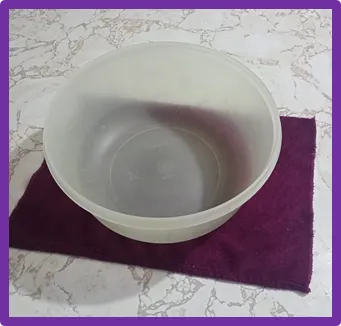

Primeramente, les comento que yo acostumbro colocar un pañito húmedo debajo del envase donde prepararé la masa. Esto con la finalidad de que el envase no se mueva al amasar la masa.
First of all, I usually place a damp cloth under the container where I will prepare the dough. This is so that the container does not move when I knead the mass.

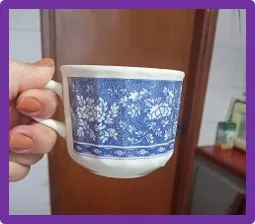

Esta es la taza que yo utilizo para medir la cantidad de agua y de harina, pero pueden guiarse por las cantidades señaladas en gramos(g).
This is the cup I use to measure the amount of water and flour, but you can be guided by the amounts indicated in grams(g).

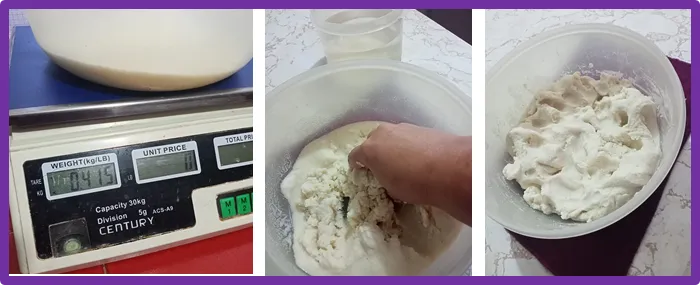

Comencemos:
Vamos a utilizar 2 tazas de harina de maíz (415 g), las cuales colocaremos en un envase hondo. Luego agregamos: 5gr de sal y 2-3/4 de tazas de agua (660 gr). Mezclamos hasta que todos los ingredientes queden completamente unidos y dejamos reposar la masa durante 5 minutos.
Let's start:
We are going to use 2 cups of corn flour (415 g), which we will place in a bowl. Then add: 5gr of salt and 2-3/4 cups of water (660 gr). Mix until all the ingredients are completely united and let the mass rest for 5 minutes.

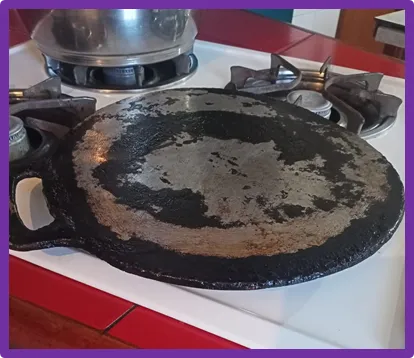

Mientras esperamos que pasen los 5 minutos, colocamos en la estufa un budare (o aripo en el oriente venezolano), que no es más que una plancha circular generalmente elaborada en hierro fundido o arcilla (el mío es de hierro fundido). En este budare vamos a cocinar parcialmente nuestras arepas.
While we wait for the 5 minutes to pass, we place a budare (or aripo in eastern Venezuela) on the stove, which is nothing more than a circular griddle usually made of cast iron or clay (mine is cast iron). In this budare we are going to partially cook our arepas.

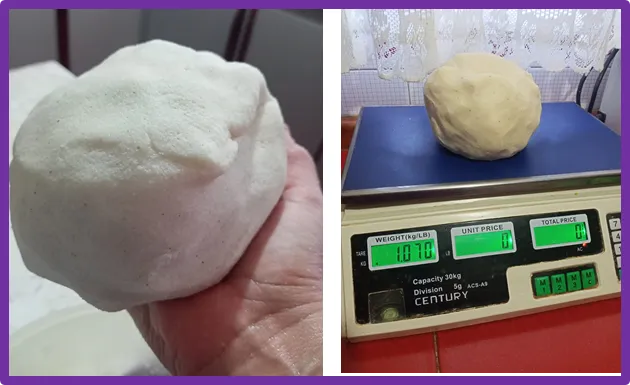

Una vez pasados los 5 minutos, colocamos la masa sobre una superficie plana (mesada), nos humedecemos las manos con un poco de agua y procedemos a amasar la masa empujándola con la palma de las manos contra la mesada hasta obtener una masa suave que no se pegue en las manos (aproximadamente 5 minutos). La masa resultante pesará aproximadamente 1070g.
After 5 minutes, place the mass on a flat surface (countertop), moisten your hands with a little water and proceed to knead the mass by pushing it with the palm of your hands against the countertop until you obtain a soft mass that does not stick to your hands (approximately 5 minutes). The resulting a mass will weigh approximately 1070g.

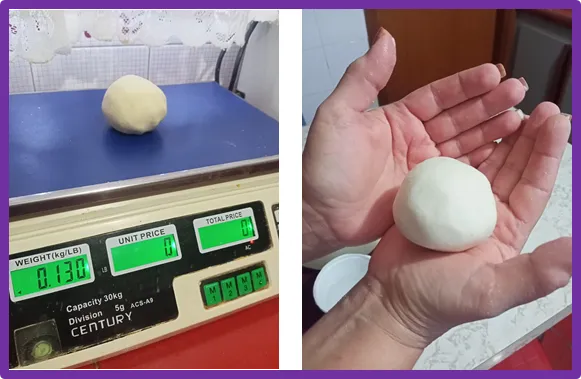

Ahora debemos separar la masa en 8 porciones de aproximadamente 130g cada una. Colocar cada porción entre ambas manos haciendo movimientos circulares para obtener bolitas lo más redondas posible.
RECOMENDACIÓN: mantener siempre las manos húmedas para manejar mejor la masa y evitar que se pegue de las manos.
Now separate the mass into 8 portions of approximately 130g each. Place each portion between both hands making circular movements to obtain small balls as round as possible. RECOMMENDATION: always keep your hands moist to better handle the mass and prevent it from sticking to your hands.

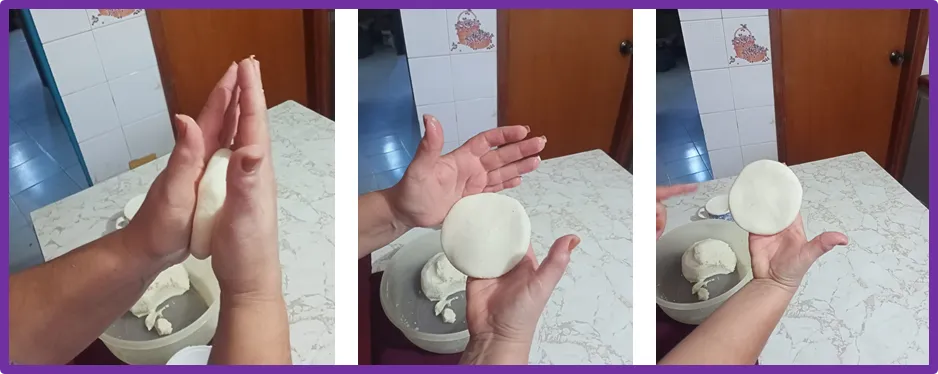

Luego aplanar la bolita con ambas manos para formar un disco, y utilizar la palma de las manos para alisar el borde del disco y lograr que éste quede lo más liso posible y sin grietas.
Then flatten the ball with both hands to form a disk, and use the palm of your hands to smooth the edge of the disk to make it as smooth as possible without cracks.

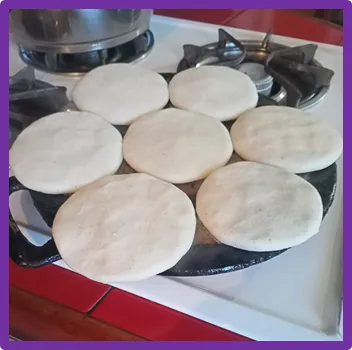

Luego debes frotar el budare caliente con un poco de manteca o aceite, colocar las arepas. No importa si las arepas sobresalen del budare porque lo que queremos es que se les forme una película delgada para luego llevarlas al horno.
En mi budare solo caben 7 arepas, así que tendré que cocinar la otra arepa cuando retire las primeras 7.
Mientras se cocinan las arepas en el budare, calienta el horno a temperatura máxima.
Then rub the hot budare with a little butter or oil and place the arepas on it. It doesn't matter if the arepas stick out of the budare because what we want is that they form a thin film and then take them to the oven.
My budare only holds 7 arepas, so I will have to cook the other arepa when I remove the first 7.
While the arepas are cooking in the budare, heat the oven to maximum temperature.

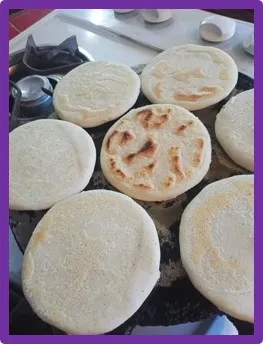

Dejar cocinar las arepas sobre el budare a fuego medio-alto durante 5 minutos por cada lado. Debes estar pendiente porque la del centro siempre se cocina más rápido y se puede quemar. Cómo a mí me gustan las arepas bien tostadas, la del centro siempre es la mía 😁.
Cook the arepas over medium-high heat for 5 minutes on each side. Be careful because the one in the center always cooks faster and can burn. As I like my arepas well toasted, the one in the center is always mine 😁.

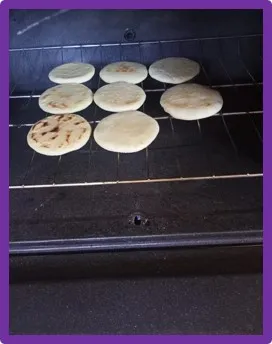

Una vez formada la capa por ambos lados de las arepas, hornearlas a temperatura máxima durante 15 minutos. Voltéalas a mitad del tiempo para que se cocinen uniformemente.
Once the layer is formed on both sides of the arepas, bake them at maximum temperature for 15 minutes. Turn them halfway through the baking time so that they cook evenly.

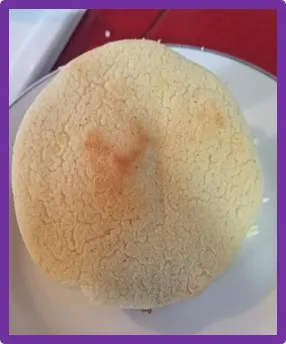

OBSERVACION: Si las arepas te quedan agrietadas, es signo de que le faltó tiempo de amasado a la masa. Pero no te preocupes, eso solo afecta un poco la suavidad de la arepa y la presentación del plato, pero el sabor es el mismo 😆
NOTE: If the arepas are cracked, it is a sign that the mass has not been kneaded long enough. But don't worry, this only affects the softness of the arepas and the presentation of the dish, but the flavor is the same 😆.

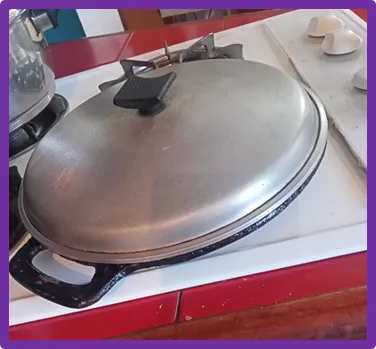

RECOMENDACIÓN: Las arepas también se pueden terminar de cocinar en el budare. Para ello se deben tapar después que se le forme la capa por ambos lados.
RECOMMENDATION: The arepas can also be finished cooking in the budare. To do so, they should be covered after the layer is formed on both sides.

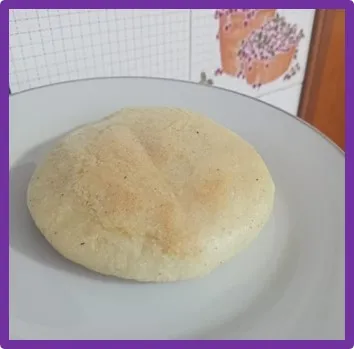

Después de horneadas, las arepas quedan ligeramente infladas, tostadas por fuera y suaves en su interior. Si no te gustan tan tostadas las puedes hornear por menos tiempo, porque en el budare ya se cocinaron parcialmente.
After baking, the arepas are slightly puffed, toasted on the outside and soft on the inside. If you don't like them so toasted you can bake them for less time, because they are already partially cooked in the budare.



Ahora rellena tus arepas con lo que desees. Las mías las rellené hoy con margarina, carne mechada y queso blanco rallado.
NOTA: La receta de la carne desmechada se las enseño en una próxima publicación
Now fill your arepas with whatever you want. I filled mine today with margarine, shredded meat and grated white cheese. NOTE: I will show you the recipe for the shredded meat in a future post.

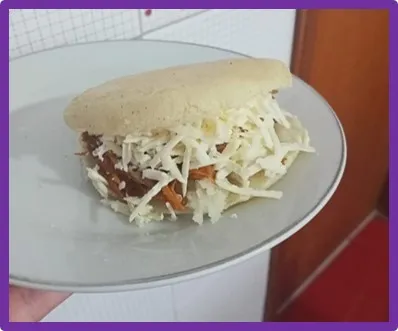

Así quedaron mis arepas.
Buen provecho!!!
Prepara las tuyas y coméntame cómo te quedaron.
Hasta la próxima entrega❤️
This is how my arepas turned out.
Enjoy!!!
Prepare yours and let me know how they turned out.
See you next time❤️

Fotos tomadas con mi teléfono realme C3 ‖ Photos taken with my realme C3 phone






15.png](https://images.ecency.com/p/YpihifdXP4WNbGMdjw7e3DuhJWBvCw4SfuLZsrnJYHEpsqZFkiGGNCQ5NnJLbc4h7wmYXxYgj5B6ovgbxeoFbo7qs9z8nB66WuQNYn2FQoakQtRQHAA1J5LbGyCDg3Nn6axFCRz3Vrnduu7EWdn1Pe3KANyDBsMBsi1vBq2oHYcW.png?format=match&mode=fit)


















































